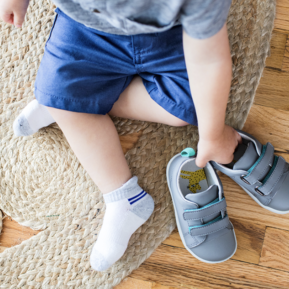Tantrums are normal, and they happen. And that’s okay, I promise you! Whether you’re out and about in the supermarket, or in the comfort of your own home, here are my top tips and tricks to help you deal with them.
Why…
Firstly, let’s try and understand why they do it. Chances are, they’re testing their boundaries and exploring their emotions, so how you manage them is really important. This is where you lay down the rules and show them that you’re the Boss from the get go. I always think a ‘firm but fair’ approach works well for children of any age. They could be hungry, over whelmed, nervous, over excited, going through a big change. Try and understand why this tantrum has happened, and therefore we can manage it a bit better.
Communication…how to handle it…
Don’t totally freak out if they say ‘no’. It’s not always a ‘bad’ thing, and this may mean that they are strong willed, and this isn’t necessarily a negative. One day, you’ll want them to be able to stand up for themselves in the playground. But let’s teach them as and when this is a good time to say. I find the best way it to get down to their level to talk to them, this way they know you mean business. Try and rephrase what you are going to say, avoiding ‘no’ and reason with them. No matter how big or small they are, always talk it out with them.
Emotions are running high when a child has a tantrum. They are still figuring out how to control their emotions (who isn’t...?!), so we need to support and comfort them. I find it best to do this once they’ve calmed down, you’ve spoken the situation through, and then you can cuddle and support them emotionally.
Consistency is key…
Whether it’s you handling the situation, the grandparents, your nanny, nursery, anyone….it is so important you are all on the same page. Not only will this make it easier for your little one to understand and process, but in the long run it’ll make it easier for you. And trust me, you’re in it for the long haul. There is nothing worse than an emotionally confused child!
Time Out…why it works & how to do it…
Time Out spots are a great time and place for your child to think and reflect what has just happened. This gives them time to process that what they have done, wasn’t necessarily okay. If at this point they are having a mega meltdown, it also gives them time to calm down and just have some space. Equally, this also gives you the chance to take a couple of minutes to process the situation and how you are going to handle it. Keeping calm is vital, they will vibe this off of you, and you want to avoid a shouting battle!
Be consistent with your Time Out spot. Avoid their bedrooms, as this is their space and you don’t want them to dread going here as it’ll eventually effective their sleep. Find a designated spot and stick to it.
I find a minute for every year of age is plenty, and remember to set a timer! Talk to your child, ask them why they feel they’ve been sent to Time Out. Hopefully they can give you a half decent answer. If they are too little to verbally explain, still chat to them. Explain that you understand they may be feeling frustrated etc, but the way in which they acted isn’t okay. Avoid saying the word “no” as they’ll copy this. Try and rephrase the saying such as “let’s see if we can find a better way to…” or “next time, let’s try using our kind hands.” Positive reversed phycology is a great way of letting them know that something that isn’t necessarily okay, in a relatively positive way.
Reward charts…why it works & which ones…
Reward charts are great for all ages as they can visually see they are being rewarded. This makes the end goal much more reachable, as sometimes children struggle to picture the end goal. Children’s perception of things when they can’t physically see it, can be very confusing!
I believe that you should never reward for good behaviour, this is something that should always (hopefully) be happening. But let’s be realistic…children may need a little bit of encouragement in certain areas. And that’s okay! Keep the reward charts specific for their purpose and don’t generalise them. This will make it much easier for your little one to understand and strive to reach that end goal. Never take away something that they have earned. Once they’ve earned that reward (for whatever reason it may be!), it’s theirs forever.
If you’re feeling creative, grab out those pens and paper and get making a star chart. They don’t need to be particularly fancy, but if you’re using stickers, definitely go with their flavour of the week. If not, you can get some fun personalised ones…
Not fancy the typical chart? An empty jar and some marbles, pompoms or dried pasta will also do the job!
Talk…
Talk to them and try and understand why they were feeling the way there were. Let them know you understand their emotions, but perhaps next time they need to go about it in a different way. If they’re older and don’t feel like talking, let them write it out in a diary. A problem shared, is most definitely a problem halved.
Comforting them...
Comforting is key, and who doesn’t love a hug?! Once your little one has calmed down, apologised if necessary, make up. Especially if this has happened just before bedtime. I know you may still be baffled by their actions at this point, but to them, to feel loved, safe and secure again is super important. This will have an impact on going forward to their actions in the future.
Sign up today for unlimited access:
- Book appointments
- Expert advice & tips
- Premium videos & audio
- Curated parenting newsletters
- Chat with your bloss community
- Discounts & competitions
- Special events





Leave a Rating / Review
You must be logged in to post a comment.